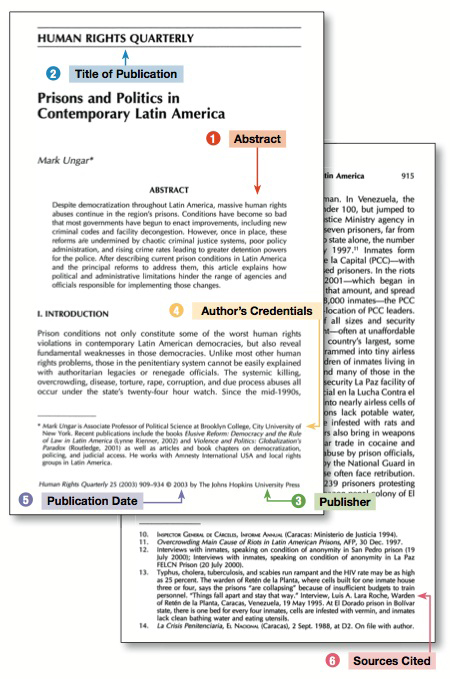
A couple of people have written asking for samples of good informational abstracts. I think in our case, it’ll be important for you to include your method (contextual analysis), your framework (ideological, historical, cultural, social, etc.), and a summary of your findings, conclusion, or the implications of your research (“Every wolf in Yellowstone therefore is more than just a wolf. Imbued with profound symbolic meaning, each wolf embodies the divergent goals of competing social movements involved in the reintroduction debate”).
Here are some good resources:
From our Writing Center:
The Publication Manual of the American Psychological Association (p. 26) suggests that good abstracts are written in a way that is accurate, non-evaluative, coherent and readable, and concise.
- Accurate: Give your reader a clear idea of the purpose and content of your paper. Avoid adding anything extra, superfluous, or overly detailed.
- Non-evaluative: Think of it as a report rather than a sales pitch. You don’t need to “sell” your paper or comment on it. Rather, give a clear summary of your work.
- Coherent and readable: Use language that is clear and understandable. Use active voice rather than passive voice. ( e.g., Participants took a survey rather than A survey was taken by participants).
- Concise: Don’t try to cover everything in your paper. Choose the four or five most important points of your work; these points can refer to concepts, findings, or implications. Use key words from your paper, especially words you think readers will use when doing electronic searches.
Informational abstracts
- Communicate contents of reports
- Include purpose, methods, scope, results, conclusions, and recommendations
- Highlight essential points
- Are short—from a paragraph to a page or two, depending upon the length of the report (10% or less of the report)
- Allow readers to decide whether they want to read the report
Examples from the UW-Madison Writing Center — see especially “Humanities Abstracts” and “Social Science Abstracts”:
Humanities Abstracts
“Margaret C. Anderson’s Little Review”
Sophia Estante and Lorrie Moore (Mentor), English
This research looks at the work of Margaret C. Anderson, the editor of the Little Review. The review published first works by Sherwood Anderson, James Joyce, Wyndham Lewis, and Ezra Pound. This research draws upon mostly primary sources including memoirs, published letters, and a complete collection of the Little Review. Most prior research on Anderson focuses on her connection to the famous writers and personalities that she published and associated with. This focus undermines her role as the dominant creative force behind one of the most influential little magazines published in the 20th Century. This case example shows how little magazine publishing is arguably a literary art.
“The Commemoration and Memorialization of the American Revolution”
Benjamin Herman and Jean Lee (Mentor), History
This project involves discovering how the American Revolution was remembered during the nineteenth century. The goal is to show that the American Revolution was memorialized by the actions of the United States government during the 1800s. This has been done by examining events such as the Supreme Court cases of John Marshall and the Nullification Crisis. Upon examination of these events, it becomes clear that John Marshall and John Calhoun (creator of the Doctrine of Nullification) attempted to use the American Revolution to bolster their claims by citing speeches from Founding Fathers. Through showing that the American Revolution lives on in memory, this research highlights the importance of the revolution in shaping the actions of the United States government.
Social Science Abstracts
“Subtype of Autism: Developmental Verbal Dyspraxia”
Amanda Babin and Morton Gernbascher (Mentor), Psychology
The purpose of this research is to identify a subtype of autism called Developmental Verbal Dyspraxia (DVD). DVD is a motor-speech problem, disabling oral-motor movements needed for speaking. The first phase of the project involves a screening interview where we identify DVD and Non-DVD kids. We also use home videos to validate answers on the screening interview. The final phase involves home visits where we use several assessments to confirm the child’s diagnosis and examine the connection between manual and oral motor challenges. By identifying DVD as a subtype of Autism, we will eliminate the assumption that all Autistics have the same characteristics. This will allow for more individual consideration of Autistic people and may direct future research on the genetic factors in autism.
“The Tony Hawk Learning Project”
Lauren Silberman and Elisabeth (Betty) Hayes (Mentor), Curriculum & Instruction
The study is to show how even a “sport” video game can incorporate many types of learning, to call attention to what might be overlooked as significant forms of learning, and to understand and take advantage of the opportunities video games afford as more deliberate learning environments. The aspects explored are the skills and techniques required to be successful in the game, the environment that skaters skate in, the personal vs. group identity that is shown through the general appearance of the skater, and the values and icons that the game teaches players. We are finding that sport video games support learning; we hope to find how one learns about oneself as a learner from playing.

